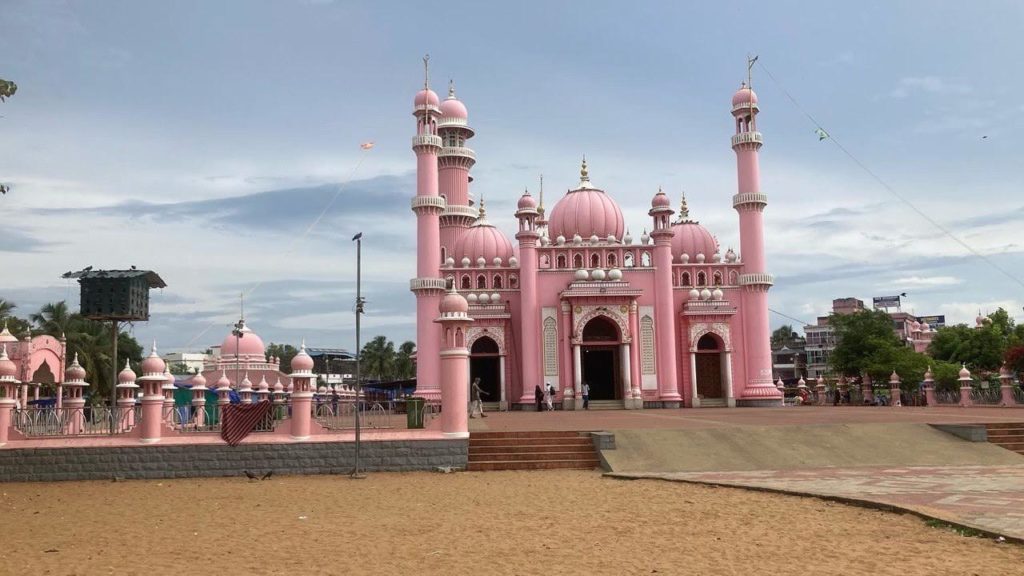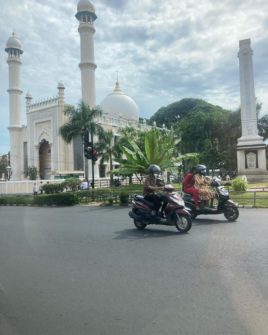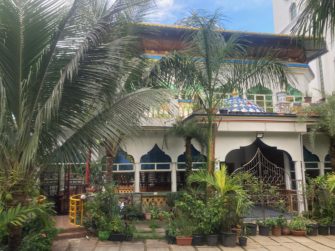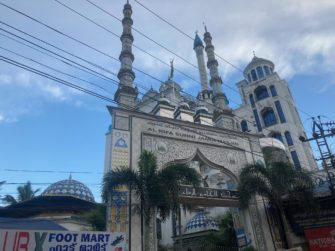
Minarets are a vital part of mosque structures. Their primary objective is to amplify a muazzin’s call to prayer. However, they also serve as visible markers of the presence of Muslims and their culture in a society. As our plane descended towards the Thiruvananthapuram airport, our eyes zoomed in on the city’s surface. This descent in a plane is always a sort of mystical experience for me: as if I am becoming a part of something bigger than myself. Soon, my friend and I who were on the journey together could discern the structures amidst the thick web of palm trees. Some minarets and domes, in their striking colors, stood out. The distinct structure of these minarets and domes hinted at their beautiful architectural style. These views piqued my interest in exploring the mosque structures and Muslim culture in the city of Thiruvananthapuram, also known as Trivandrum.
This was my first visit to a city in South India. I have many Muslim friends from this region who currently live in New Delhi, where I also live. They come from racially and culturally distinct backgrounds, yet share many similarities with those native to North India. Even North Indian Muslims, who have lived for many years in India, have not fully assimilated into the local traditions, at least psychologically. As per my own observations, the North Indian Muslims are still proud of their foreign ancestry and culture and the distinct traditions that they developed after their arrival, which persist in the lives of local converts still today. In contrast to this, the South Indian Muslims’ cultural ancestry germinated from their native place in India and seems to have more strongly affected their religious identity. I have always been fascinated with these striking differences. So, when my friend invited me to join him on this trip, I saw it as an opportunity to witness firsthand and explore it by myself.
Thiruvananthapuram is the capital city of the state of Kerala. Like many other Indian cities, it is also a home for multiple religious communities, but here they are all blended in a similar ethnic tradition. However, the specific religious affiliations of its people cast a distinguishable tinge on their cultural identity. The city is dotted with magnificent temples, mosques, and churches, the monuments of history narrating an age-old story of the diversity and coexistence within the city. When I arrived here, I realized that I wanted to explore how the pluralistic nature of the city had impacted its Muslim inhabitants and their culture. I was drawn to the city’s pluralism because it was on such clear display in the architecture, dress, and customs of the people living in it. For me, pluralism not only denotes a tolerance towards others, but also offers an opportunity to intermingle and exchange and thus mitigate differences. Because they are pluralistic, societies like those in Kerala tend to be more welcoming of societal changes. As I will discuss later, it is this pluralism that led Keralite Muslims to be the first in India to introduce changes to their madrasa curricula. I believe that the Muslims of India, and India herself, need this kind of pluralism today, rather than the kind of split between different cultures and communities that the current political climate is promoting.
Early Muslim Interactions in Kerala
The seaside of the region where the state of Kerala is located has been inhabited since antiquity. And Islam, soon after its birth, found a home here. Historians believe that even before the emergence of Islam in Arabia, Arabs had established trade relations with the people of southern India. The trade between the two communities might have precipitated civilizational transactions as well. Arabs respected Indian people, and many Muslim travelers who traveled to India have admired the country and its people in their travelogues. Sulaiman, an Arab merchant, was one of the earliest writers who wrote about the coast of Malabar, which he is believed to have visited in 851 AD. He observed that Quilon (Kollam) was “the most considerable port in South India at that time” (11–12). The port of Quilon is around 67 km (about 42 miles) from Thiruvananthapuram. The most illustrious Muslim traveler, Ibn Battuta visited the Malabar region multiple times and provides a detailed account of its kings, people, their customs, markets, and trades. Ibn Battuta mentions that there were no Muslim residents in Malabar. Therefore, Muslims traveling to the region had to rely on the natives for food and lodging. However, as per the customs, neither were Muslims allowed to dine with the natives nor were they welcomed in their houses. The Prophet Muhammad is also reported in a weak tradition to have said that he felt a divine (rabbānī) fragrance coming from India (3). According to a popular Muslim tradition, the first man, Adam, descended from Heaven to the Indian peninsula. Such traditions have always inspired love and reverence in the hearts of Muslims for the country. The trade relationships between Arabs and South Indians continued flourishing after the conversion of Arabs to Islam. The story goes that these traders were the first people who introduced Islam to India, long before the advent of Islam in the northern parts of the subcontinent, which is now seen as its home in the nation. Islam was introduced to South India through peaceful means facilitated by the already established trade relationships, but in North India, Islam was introduced by invading armies and imperialist forces. The different ways in which Islam came into the country would later play a crucial role in determining the relationship of Muslims to their fellow countrymen in terms of social and political coexistence in both pre-colonial and post-colonial India.
For me, pluralism not only denotes a tolerance towards others, but also offers an opportunity to intermingle and exchange and thus mitigate differences. Because they are pluralistic, societies like those in Kerala tend to be more welcoming of societal changes.
I believe it was the nature of their arrival in the region of Kerala that allowed these Arab Muslim traders to assimilate into the local culture. Those who converted to Islam also followed the acculturated Muslims by retaining their unique ethnic and linguistic identities. They lived with their countrymen peacefully and prospered for centuries. These Muslims rose to high positions and participated in social and political life. Even today, one cannot distinguish a Keralite Muslim only by his or her looks and language unless he or she is either wearing a hijab/burqa or coming from an ulama class. Many ulama in Kerala wear a white turban, which is very different from the turban that some ulama and Sufis wear in North India. These North Indian ulama and Sufis do not limit themselves to the white color only. It should also be noted that not all ʿUlamāʾin Kerala wear a white turban and not every woman wears a hijab or burqa. In Thiruvananthapuram, I saw very few people observing this type of dress code. Wearing a turban is not a mandatory practice in Islam. It is believed to be a voluntary sunnah of the Prophet Muhammad, which some Muslims (especially ulama and Sufis) observe in an attempt to imitate the Prophet as much as possible. Not only does the turban signify their supplementary commitment to piety, it also differentiates them from the non-ulama class. Other than the turban and the hijab/burqa, there are no noticeable features that could contrast the Muslims in this region with other Keralites. This cultural and linguistic continuity across religious differences in Kerala society is remarkable and makes it unique in our country.
Kerala’s Diverse Architecture
This sense of rootedness and belonging is also reflected in the modern and elegant structures of mosques in Trivandrum, many of which were designed by a Hindu architect, Govindan Gopalakrishnan, who is also known as the “Mosque Man.” Gopalakrishnan worked with his father in the reconstruction of Trivandrum’s famous mosque, Masjid-e-Jahan Numa (commonly known as Palayam Pally or Palayam Mosque), and designed by himself another beautiful mosque in Beemapally. The designs of both mosques are exquisite examples of the Indo-Islamic architectural style. In what follows, I describe this architecture by drawing on the information I gathered while visiting the mosques and the people I spoke to there.

On my way to Beemapally, I spotted the Palayam Mosque. Facing a busy road, the sight of the mosque is a treat for sore eyes. Its majestic façade accentuated by slender columns and a double arch fills its beholder with excitement. The towering minarets standing on the two corners of the façade further contribute to its grandeur. Through the middle of the arch, one can also see a chhajja hanging on the inner wall, which is used as an ornament of the arch. Chajja originated in India as an architectural element and was widely used in mosques and palaces during the Mughal period. The heads of the minarets are adorned with chhatri, another Indian architectural element, and their body with lotus petals. The Lotus flower has religious significance in Hindu culture and architecture. One of the Hindu goddesses, Lakshmi is usually depicted standing on a lotus flower. It also has an elegant white onion dome in the middle of the mosque, whose base is also embellished with lotus petals. The edges of the roof and the walls of the mosque are decorated with chhatris and chajjas. This eclectic design of the mosque, which incorporates the Hindu and native cultural and religious symbols, expresses an inclusive tradition of the Muslims in southern India.
Beemapally is a coastal region in the district of Thiruvananthapuram. It is the home of one of the most prominent and elegant religious structures in the state: a mosque and a dargah, the resting place of a saint or saints where people come and pay their respects. Even though the foundation stones of the current buildings were laid in 1967, the shrine and the mosque have been there for almost 800 years. According to local tradition, the dargah enshrines the grave of two saints, one of whom is female, Syedunnisa Beema Beevi, and the other is her son, Syedu Shuhada Maheen Abubacker. “Beemapally” means “the Mosque of Beema,” signifying the affiliation of the place with this female saint. Now the whole place is referred to by the same name. It is said that Beema Beevi came from Mecca to this region along with her son 800 years ago and settled there, becoming one of the first Muslims who preached Islam to the people living here.
For hundreds of years, the mosque and the dargah were housed in small buildings, which almost 50 years ago were replaced by the current grander structure. Designed in a T-shaped plan, the mosque and the dargah are two independent structures, with the entrance of the mosque facing towards the east, and the dargah towards the south. The central doorway of the dargah leads through a projected full-height façade positioned between two recessed front doorways, which are ornamented by pointed arches, slender columns, elegant motifs, and Arabic calligraphy. Two lofty minarets are placed on the corners of the façade. The dargah has four onion domes, three of them, beautifully proportioned, are situated on the front, and the fourth, the big one, is in the middle of the structure indicating the place of the burial of the two saints. Both buildings are painted in pink and white, an unusual combination that is hard to find in northern India. Together, these elements exhibit a graceful and astonishing view. Even though the mosque structure does not have any dome, it does have a colossal front. Flanked by two massive minarets, the front of the mosque is adorned with two arches and a chajja on the inner wall. Like the Palayam Mosque, the walls and edges of the roof are decorated with a series of chajjas and chhatris and lotus flowers.
As much as the exterior of these structures offers a sight of magnificent craftsmanship, the bleak atmosphere of the inside of the buildings leaves their visitors disappointed. The inside of the mosque and dargah is structured into huge plain halls. As I entered them one after the other, I found devotees and worshipers scattered around the halls, sitting, worshipping, or just lying on the floors. I tried to talk to some of them, but I could not because they could speak neither Hindi or English nor did I know Malayalam, the native language of Kerala. I stared at the lifeless walls of the halls, interspersed by large dark-colored windows, and I wondered how they could not make the interior of the buildings as elegant as their exterior. Religious places are not merely places of worship. They are supposed to inspire the imagination of the followers of the religion they are devoted to. A mosque should be meant to offer an experience of the two aspects of the divine, which according to Muslim tradition, are referred to as Jalal, the glory, the greatness, and Jamal, the beauty, of the divine. If a mosque fails to offer such an experience to the worshippers, it loses a substantial part of the purpose of its existence. Muslims in medieval India were aware of the aesthetic importance of religious places in influencing the spiritual experiences of worshippers. They built exquisite mosques and decorated them with elaborate artistic expressions. Modern mosque structures in India miss the old complex creativity. Sometimes, the outward appearance of these structures captivates their beholders. But their insides, as in the case of Beemapally, seem to be deprived of any imagination. Aside from distinct features, such as niches or arches, the interiors are just combinations of walls, beams, and roofs. Such comparison forces one to ask about the reason behind this withering of the once beautiful tradition. I believe it is because of the dominance of the ritualistic puritanical understanding of Islam which insists on viewing a mosque merely as a place of worship. This theological position, puritanical in the sense that it views the accretion of other cultures into an Islamic one as unorthodox, to some extent is also opposed to pluralism. It has led to a cultural bankruptcy whereby Indian Muslims lack confidence in creatively engaging with their tradition and their past.
Religious places are not merely places of worship. They are supposed to inspire the imagination of the followers of the religion they are devoted to.
The dargahs in North India, such as the dargah of Nizamuddin in Delhi, or the dargah of Muinuddin Chishti in Ajmer, have as their central parts the places of the burials of the saints, and these are accessible to devotees to offer their tributes to the saints. However, the graves of the saints in the dargah of Beemapally are off-limits to devotees. Instead, these devotees are mediated by some individuals, who in North India we call mujabir or khadim. They stand at the gate of the chamber which contains the graves of the saints and offer a spoonful of water and oil to the people who reach them. But they do not allow them inside to pay their respects to the saints. Near the dargah is a well, whose water is believed to have healing qualities. The dargah and the masjid of Beemapalli are managed by a trust, which also runs a madrasa outside the campus of the dargah.
After these mosques, I planned to visit a small local madrasa that is run inside an al-Rifa Sunni Jamia Masjid, Tholicode, Thiruvananthapuram.
Visiting the Madrasa

I have found that talking to authorities in masjids and madrasas is a challenging task during my many visits around India. Often, they are suspicious and refuse to talk. In this madrasa, however, I found some senior-year students who seemed interested in talking to me. I asked questions about the curriculum they were studying and we discussed some contemporary issues that are challenging the classical madrasa system. I learned that they have been studying some classical key texts on Islamic sciences along with the Central Board of Secondary Education (CBSE, a national-level board of education in India for public and private schools controlled by the Government of India) curriculum and have cleared the Secondary School Examination (10th) and are preparing for Senior School Examination (12th). They told me that their madrasa runs classes for both curriculums so that after graduating from the madrasa they can pursue higher studies in universities as well, which many of them expressed interest in doing.
The curriculum of the madrasa in Tholicode is not exceptional in Kerala: Other madrasas are treading the same path. One of my friends, who studied in one of the famous madrasas of Kerala, Darul Huda, in Malappuram, explained to me how this conjoined system of modern and classical curriculum functions. From the morning till the late afternoon, classes are conducted on Qur’an, Hadith, jurisprudence, Arabic, and modern subjects. He also told me that after graduation, most of the students of his madrasa studied social sciences in central and state universities and were able to obtain the highest degrees in education.

As I mentioned earlier, pluralistic societies, in their nature, are more welcoming of changes. A religious society interacts with others as far as its theological doctrines allow. The more the theological doctrines are flexible the more the society in which it is located tends to be adaptable. The religious societies that are pluralistic today have maneuvered through their theological doctrines, developing them to be more open and accommodating. Conversely, non-pluralistic societies tend to be rigid and unaccepting of changes since they have developed their theology in ways that do not allow them to be so. This distinction can be observed in terms of culture and education, which I have discussed in this essay, in the two different societies that Muslims inhabit and help create in northern and southern India.
The visit to Tholicode concluded my trip. I spent four days in the city. During this short duration, I could visit only a few places. But many times, a little peek through the windows of mosques, churches, and temples was enough to cause a sensation. Many mosques in white, green, blue, and pink colors, which I caught glimpses of on my way are still circling in my head. It was an enlightening adventure. I learned so many things in just a few days. I learned about the eclectic nature of the Muslims of Thiruvananthapuram, which is represented in their culture, architecture, and even in their religious education system. Madrasas in these regions are trying to bridge the chasm between their classical curriculum and the needs of modern times. The eclectic model of the Muslims of the city can offer great lessons to the Muslims of North India and help them reduce their cultural differences and introduce reform to their madrasa education.

